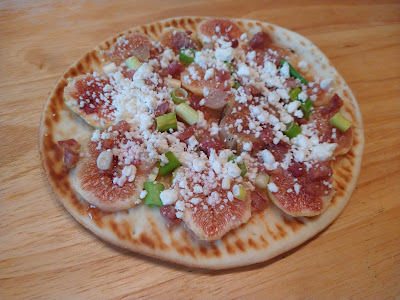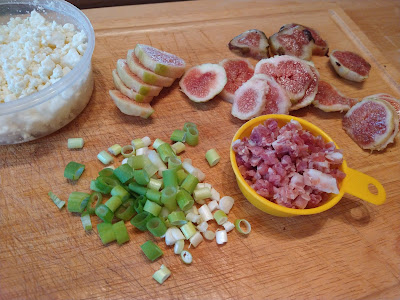
Recipe: Fig, feta and prosciutto pita pizza can be grilled or baked
 |
|
Here's the pizza, hot off the grill. (Photos: Debbie Arrington)
|
Figs need summer heat to ripen. When that summer heat comes in May or June (as it did this year), local figs are ready to pick in early July instead of August.
Right now, Mission figs are turning deep, rich purple. They’re at their peak of flavor when they come off the tree with barely a touch.
So, instead of waiting until Labor Day, we can enjoy ripe figs on the Fourth of July.
This easy recipe makes the most of ripe figs, combining other Mediterranean ingredients – pita bread, olive oil, prosciutto and feta – into fun food for the Fourth or anytime this summer.
Too hot to turn on the oven? This pita pizza works great on the grill, too. And the recipe can be easily multiplied to serve as many people as needed, either as an appetizer or main course – as long as you have enough figs!
 |
| Simple ingredients for a delicious summer pizza. |
Fig, feta and prosciutto pita pizza Makes 1 serving
Ingredients:
1 pita bread
1 teaspoon olive oil
2 ripe figs, peeled and sliced about ¼ inch thick
1 tablespoon chopped scallion
2 tablespoons prosciutto, chopped
2 tablespoons feta cheese
Instructions:
Preheat grill or oven to 400 degrees F.
Lightly brush one side of pita bread with olive oil. Assemble ingredients, placing (in order) fig slices, chopped onion, chopped prosciutto and feta cheese on top, evenly distributed over the pita bread.
Place pita pizza directly on rack of grill or oven. Grill or bake until feta is soft and prosciutto is heated through, about 8 to 10 minutes.
Serve immediately.
Note: To avoid over-cooking bottom of pita bread, grill over indirect heat.
Comments
0 comments have been posted.Sacramento Digs Gardening to your inbox.
Sites We Like
Garden Checklist for week of July 21
Your garden needs you!
* Keep your vegetable garden watered, mulched and weeded. Water before 8 a.m. to reduce the chance of fungal infection and to conserve moisture.
* Feed vegetable plants bone meal, rock phosphate or other fertilizers high in phosphate to stimulate more blooms and fruiting. (But wait until daily high temperatures drop out of the 100s.)
* Don’t let tomatoes wilt or dry out completely. Give tomatoes a deep watering two to three times a week.
* Harvest vegetables promptly to encourage plants to produce more. Squash especially tends to grow rapidly in hot weather. Keep an eye on zucchini.
* Pinch back chrysanthemums for bushy plants and more flowers in September.
* Remove spent flowers from roses, daylilies and other bloomers as they finish flowering.
* Pinch off blooms from basil so the plant will grow more leaves.
* Cut back lavender after flowering to promote a second bloom.
* It's not too late to add a splash of color. Plant petunias, snapdragons, zinnias and marigolds.
* From seed, plant corn, pumpkins, radishes, winter squash and sunflowers.